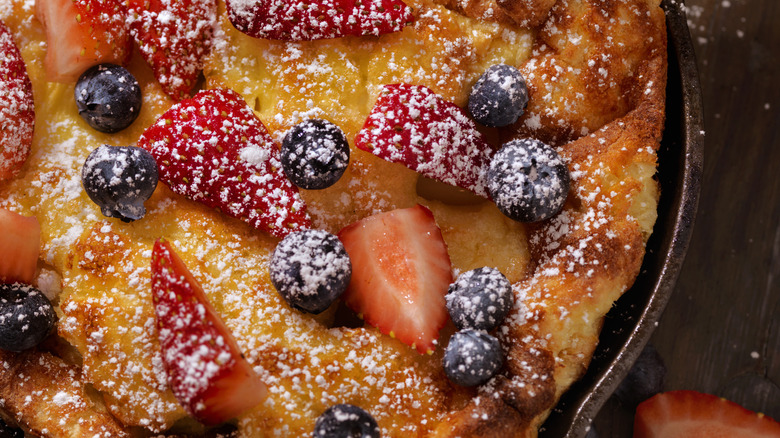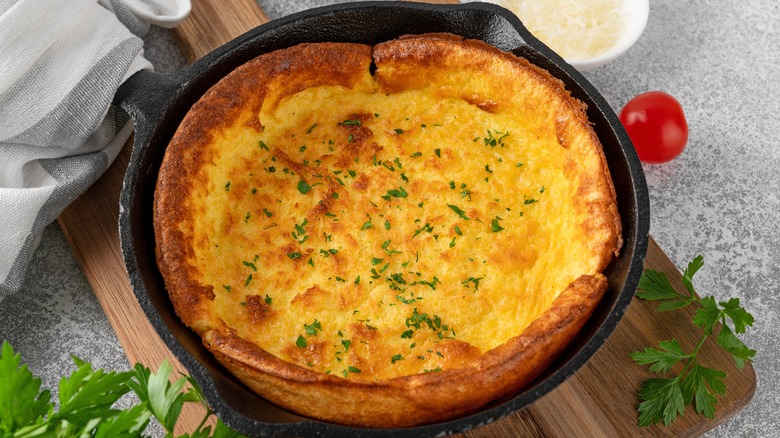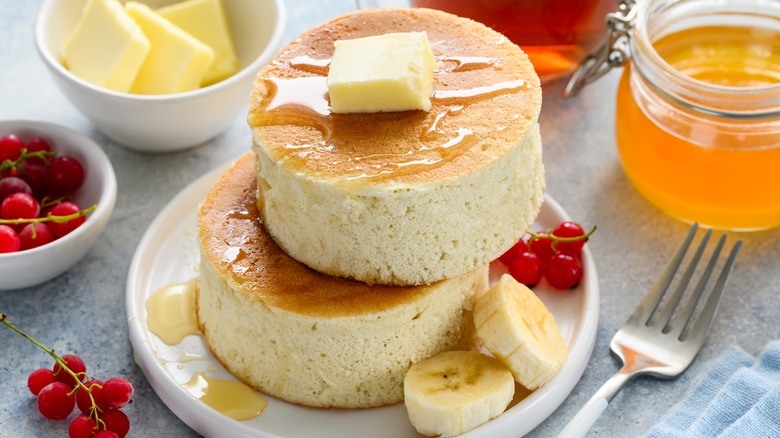German Vs Japanese Pancakes: What's The Difference?
There are some pancakes you'll want to eat every day as what's not to love about a fluffy canvass that has endless customization options? It wouldn't really be hyperbolic to say that the world thoroughly loves these doughy concoctions. Humans have been eating pancakes since around 600 BC. Throughout the centuries, the humble dish has been made in thousands of different ways. Each type has its own charm, but one thing is for sure; all varieties of pancakes are special in their own way.
Speaking of pancake variety, the German and Japanese versions have some of the most interesting takes on pancakes. Each one looks different than the familiar stack of flat cakes that Americans recognize and love. Although they are made with similar doughy foundations, German pancakes and Japanese pancakes are two distinct dishes with varying textures, cooking methods, and presentation.
A key difference between the two is how they look. German pancakes are large and thin with a puffy texture whereas Japanese pancakes are thick and fluffy, like old-fashioned American pancakes on steroids. Because their composition and preparation methods are so different, they don't taste the same, either.
German pancakes
Also known as a "Dutch Baby," German pancakes are made with a simple batter consisting of flour, milk, salt, and eggs. The batter is poured into a skillet with some melted butter and baked. The result is an airy, golden-brown pancake with a flat base that can be customized in many different ways. The pancake itself has a mild, buttery, and eggy flavor.
Some like to serve German pancakes with sweet syrup and fresh fruit while others dust powdered sugar over them and eat them with a dash of lemon juice. Cinnamon apples are also a popular choice. The toppings don't necessarily have to be sweet, either. They can be served with eggs, cheese, meat, peppers, and whatever tickles your gastronomic fancy. Because they are so neutral and customizable, German pancakes can be eaten for breakfast, lunch, and even dinner.
Dutch baby pancakes are not to be confused with traditional German pancakes called "Pfannkuchen." What we know as German pancakes in the United States are actually a derivation of the traditional pfannkuchen recipe. As the story goes, a Seattle restaurateur who was credited with the recipe came up with the name after his child mispronounced "Deutsch” as "Dutch."
Japanese pancakes
Remember when the fluffiest pancakes ever were all over our TikTok feeds? The viral pancakes drizzled with all kinds of delicious syrups and fruits seemed like an absolute treat, and we weren't wrong to think that. Pancakes, as we know them, are generally fluffy, but things just can't get fluffier than the Japanese version. When made right, the thick pancakes jiggle like a jello mold. Egg whites are beaten until stiff peaks are formed and gently folded into a mixture of flour, sugar, baking powder, salt, milk, butter, vanilla essence, and egg yolk to achieve an unbelievably fluffy texture. The key is to not overmix it.
Unlike German pancakes, Japanese pancakes are made on a skillet with a little bit of butter or oil and cooked on both sides until golden brown. While German pancakes can also be served with savory toppings, fluffy pancakes taste best with sweet syrups, whipped cream, ice cream, and fruits.
Japanese pancakes didn't always look so big and pillowy. The Japanese have been enjoying pancakes since the 16th century. Back then, they used to make a simpler version with flour, water, and sometimes sake. It was often enjoyed with sweet miso paste. The soufflé pancakes rose in popularity around the 1970s after a Hawaiin diner called Eggs N' Things introduced the recipe.Regardless of whether you prefer German, Japanese, or both at different times, perfectly cooked and expertly topped pancakes will always take the cake.


